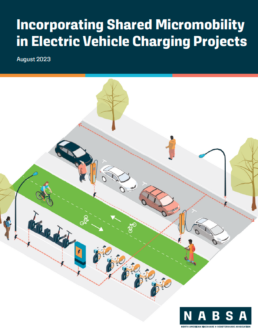NABSA Releases New Resource on Shared Micromobility Charging, Advocating for Inclusion in EV Charging Network Development
Today, the North American Bikeshare & Scootershare Association (NABSA) released a new resource advocating for the importance of including shared micromobility charging stations in overall efforts to build grid capacity for electric vehicle charging. This follows the recent publishing of NABSA’s 2022 Shared Micromobility State of the Industry Report earlier this month. This resource comes at an important time as nations and communities seek to decarbonize transportation and develop charging networks for electric vehicles, and demonstrates a multimodal approach to transportation electrification. The project was supported by ClimateWorks Foundation.
“As we progress towards moving our transportation away from oil dependency, it’s important that we optimize the design of zero tailpipe emission and compact transportation systems as much as possible. That means looking for synergies in places like charging infrastructure to reinforce multi-modality and efficiency and connectivity across electric transportation of all shapes and sizes,” said Lina Fedirko, Associate Director, ClimateWorks Foundation.
“Communities, especially environmental justice communities, that would benefit from shared micrombility need federal support to implement the charging infrastructure needed. Co-locating infrastructure for charging shared micromobility and electric cars makes sense on multiple levels. Local, state and national leaders should read NABSA’s report to more efficiently support diverse transportation options in diverse communities,” said Bridget Sanderson, Coordinator for the Coalition Helping America Rebuild and Go Electric (CHARGE).
“Electrifying transportation as a climate strategy must include bikes and shared micromobility. NABSA’s new report identifies crucial opportunities for the U.S. to invest in the future of bikeshare systems and serve communities of all sizes with connected, efficient, and affordable shared electric micromobility options,” said Noa Banayan, Director of Federal Affairs at PeopleForBikes.
“As the U.S. seeks to electrify its transportation system to achieve our critical climate goals, we must focus on the most efficient, affordable and accessible ways to connect people to their daily needs. Shared micromobility is critical in transitioning to a multimodal transportation system and NABSA’s new report provides key strategies to make the most of new transportation investments across the U.S. to build once and create multimodal transportation hubs that serve public transit, shared micromobility, fleets, and private vehicles,” said Harriet Tregoning, Director, New Urban Mobility Alliance (NUMO).
“Creating sustainable transportation systems is going to take a multimodal approach, and shared micromobility is a powerful, proven, and critical component of this ecosystem,” said Sam Herr, Executive Director of NABSA. “We hope this paper will help socialize the ways we can think, plan and implement transportation electrification across sectors and modes.”
The paper discusses the emissions reductions, mode choice, and sustainable transportation benefits that shared micromobility is realizing across North America, the popularity of electric shared micromobility, the need for scaling shared micromobility to meet user demand and transportation decarbonization goals, and what is needed to scale shared micromobility charging infrastructure to help do that. To optimize opportunities and synergize modes, the paper examines the ways that EV charging projects can be leveraged to support shared micromobility charging infrastructure development as well, and how funding can be effectively utilized to create sustainable multimodal transportation networks. This resource is meant to socialize these ideas and help encourage partners and stakeholders at all levels to think across sectors and modes as we work toward transportation decarbonization.

